
Marchena, an inheritance with no waste
Pascual Madoz, in his Diccionario geográfico-estadístico de España y sus posesiones de ultramar (Geographic-statistical dictionary of Spain and its possessions oversea) from the mid-nineteenth century, provided simultaneously data related to the state of the monuments of Marchena as crime rates. The ruinous state of the buildings was running in parallel to that of a population that, mostly its lower strata, was living in a moral ravine, where criminal offences reached an average of almost fifty per year.
In that same hot social magma moved also a kind of flamenco that, with the passing of time, gave great names in the cante (singing) and the toque (playing), but Marchena was only able then to send every year to Seville dozens of those in need of making a living by busking the songs of the storyteller from the streetcorner of the capital. From this very low level saetas arrived at the balconies of the Sevillian Sierpes Street.Type of flamenco (Palo) that consist of an aspiration/fervent prayer or couplet that a person address to the saints during the processions.
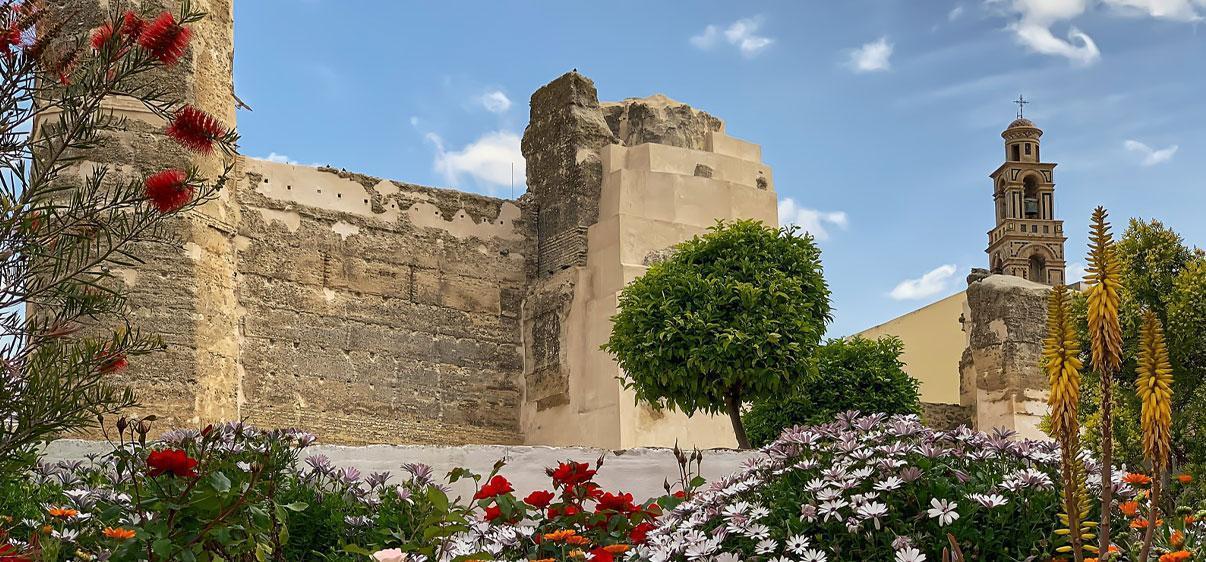
Castillo de la Mota. ©Ayuntamiento de Marchena
Those were other times. Marchena, Route of Washington Irving, lives today unfolding its whiteness under the sun. amidst the ochre and green landscape, making over the mirage of that “Marchena of the olive groves” that Ibn Arabi laid out when he visited “Jasmine, the mother of the poor”.
Barely a few farms and service buildings still divide today the olive groves and the historic quarter where the streets keep that atmosphere portrayed in the novel by Juan Valera, who was so close to the city that he left there a niece, married to a French engineer who had arrived with the railway. They turned out to be the parents of sculptor Lorenzo Coullaut Valera, author of the monument to Bécquer in the Sevillian park of María Luisa.
And it was maybe then that the fate of Marchena was cast when, almost a century ago, the railway was superseded by the road that whould connect the west to the east of Andalusia. That road, the forefather of the modern A-92, left the town out of the hustle and bustle of traffic and, paving at the same time the way for a steady growth. Neither with ups and downs, nor shocks nor rests in the low task of being tied to the knot of the past, while still being what it is today. It focused in on itself.
Marchena, in urban terms, was born with Al-Andalus, although as almost every city in Andalusia it had to abide during the Golden Age the commitment of Rodrigo Caro -and others- searching for a Roman origin for its name in the legendary Marcius or Marcellus. Eran las modas que corrían en aquellos lustros de la construcción de la “Segunda Roma”. Our Renaissance men were not in search of real origins but of a spiritual toponymy that might unify the crown and the coats of arms of Spain, that of the House of Arcos, in this case, and the Holy Roman Empire.
The Al-Andalus identity is made evident when we enter the town by its oldest part, through the gates of Morón -the one surely used by Ibn Arabí- or that of Seville -that of la Rosa- inlaid among the turrets of the old wall. Yet the wall tells us at the same time about the advent of a city that has never stopped, that has continually grown on its vital skeleton, despite stones, bricks and walls having been recovered, reshaped, recycled over the centuries by the people of old that kept the past by using it, weaving it with the threads of traditions, uses and customs, ceremonies… to enshrine it by force of repetition, transubstantiating it into the lustral water of auspicious days indicated by the calendar of the sun and the moon.
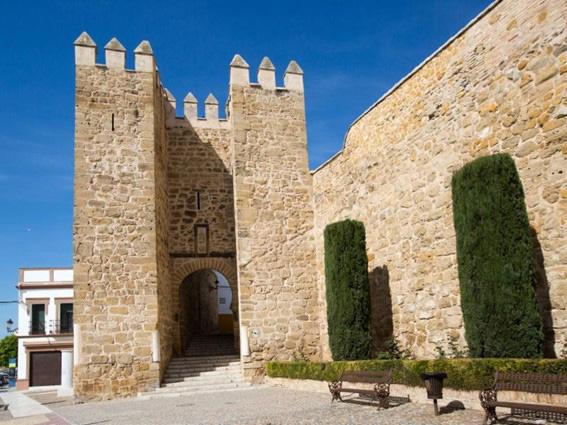
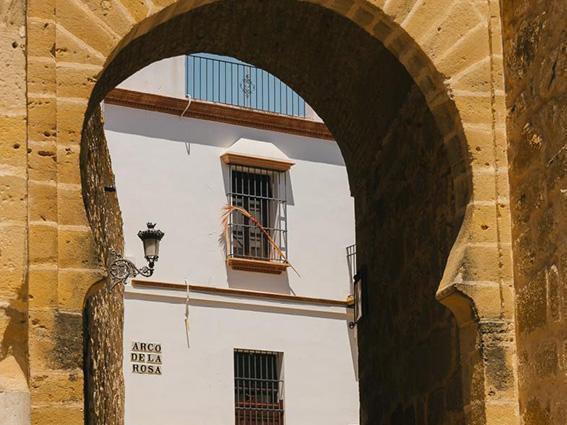
Puerta de Sevilla o Arco de la Rosa. ©Andalucía.org
Facing the gates of Marchena spread powerful, old suburbs. One of them was named Gate of Barral, that is to say, of del arrabal (of the suburb), which has ended up being integral parts, and, after the entrances we can sight the medina and the quarter of the church of San Juan, popularly considered the “cathedral” of the town. Its steep streets lead us to the marked edge of the Lords of Arcos before lying in the Plaza Ducal. Between the walled enclosure and that built at the opening of the 16th century, the Plaza Vieja is located, which was a forum, a souk and a market.
Streets with no trees, (only with white walls and naked black protrusions of grill windows, penetrated by the greys that the changing shadows provide to make an alignment of nearly perfect perspectives. Streets still bear the names of old professions, like that of the tailors or the makers of earthenware water jugs, others with memories of the convents of Amor de Dios (Love of God) or Santa Clara and a square that was Mayor, but today simply known as “de Arriba” (of the upper side) referring to its geographical position.
What happened to the Ducal Plaza what the same as what occurred with the rest of the stately squares, like the Plaza Alta de Badajoz, for example: it ended up being the symbol of the ruin of the old regime. Yet, its collapse was brought to an end by ceremony: year after year, in the early morning of Holy Friday, the processions of Jesus of Nazareth’s judgement, the Mandato (Mandate) remain here, ending with the ritual of the release of a prisoner, and, hence, of the people who set him free.
It is still possible to enter through one of their arches into the remains of the Ducal Palace, which ends in the old walls, with a barbican; at the end of the esplanade, the church of Santa María de la Mota, with a peculiar tower, that is more Greek than Sevillian despite having been designed by Hernán Ruiz, and, next to it, the convent of the Clarisses nuns whose door bears a panel of tiles from the 17th century that masterfully reproduces the image of the Immaculate by Pacheco.
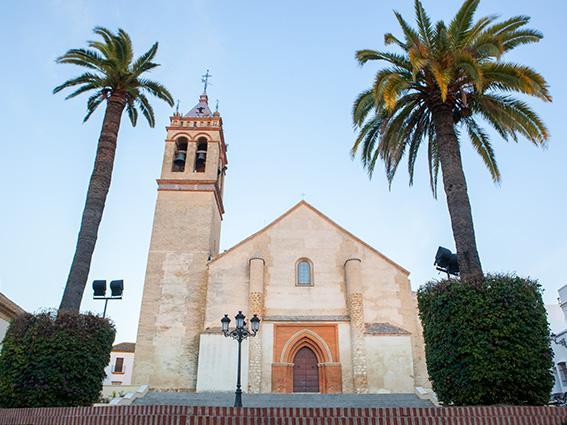
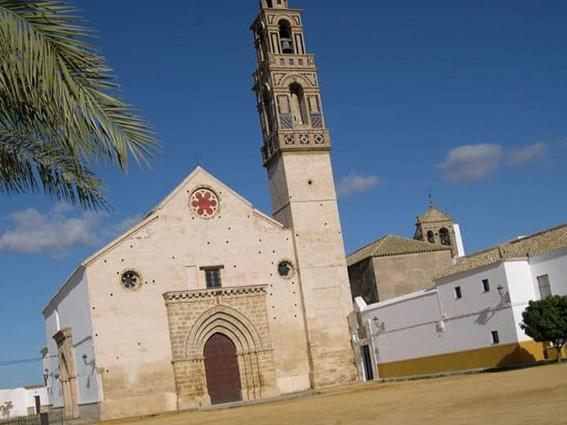
On the left, Church of San Juan Bautista. On the right, Church of Santa María de la Mota.
The traveller who enters their quiet cloister can request through the torno those sisterly sweets that accurately preserve centuries long traditions, a surprise for those who have pursued the confectionery in Morocco, as they will find the same marzipan fruits as in the medina in Tetouan.
In the empty space that gives access to this other ”field of solitude”, painted on its wall are the Gothic-Flamboyant volutes of its former door ̶ which was installed some hundred years ago in the Alcázar of Seville, following the joint desire of the Marquis of la Vega-Inclán and the American tycoon Huntington, following the dictates of a historicism that we will never know if were good or bad. The world functioned then that way, and a proof of that is the courtyard of the Vélez Blanco palace in the Metropolitan Museum of Nueva York, or the of the Córdoba’s House at the beginning of the Granadan Cuesta (slope) del Chapiz.
In any case, the dismantling had taken place earlier, and in the palace of the Marquis of Lebrija, in the Sevillian Cuna Street, among mosaics, columns and opus sectile [1] marbles from Italica, the manor house of Marchena was also assembled with all its tiles, part of its coffered ceiling and the great dome in gilded wood. Whoever wants to see it must get there.
But not everything was lost. From the old Ducal church every Holy Saturday still depart the processions of Holy Burial and the Virgin of the Soledad (Solitude): the nineteenth-century-style solemnity of its first part, that of the funerary urn by Jerónimo Hernández, turns into a popular cry around the Virgin, usually named “La Cernicalera” (“that of the kestrels), “Lady and Mister” of the birds of that species that nest since long ago in the parapets of the old fortress that are still standing.
In the nocturnal procession of the Virgin of the Solitude we can listen to the saetas carceleras . They are the most evolved of all the ones left by Marchena, the site of this lyrical treasure, Flamenco, today an Intangible World Heritage and of all Andalusia, the paradigm of sacred drama and of the human drama of a community, according to Cansinos Assens and Federico García Lorca.
The Virgin of Solitude never passed by the prison of Seville, although it is said that the Sevillian composer Manuel Font de Anta was inspired by the one sang by a prisoner from that prison, to compose his Soleá dame la mano (Soledad give me your hand). It is also said that Maurice Jarre, the composer of the soundtrack of the movie Lawrence of Arabia, who lived in Seville for a long time, was inspired by that composition for the main music of the film. For History writes with “even more crooked lines than”.
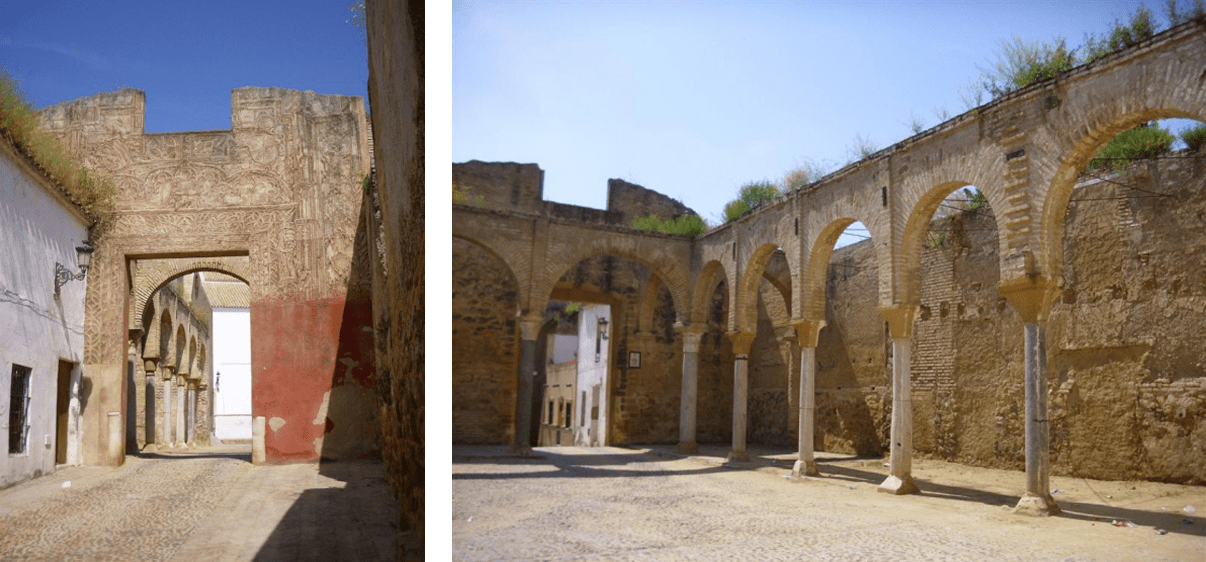
On the left, Arco or Puerta del Tiro, that gives access to the courtyard of the Ducal Palace of Marchena, on the right. ©Carlosrs.cc-by-sa3.0
Special mention must be made of the church of San Pedro. In its Baroque chancel screen still prevail the Mudejar designs included in the Tratado de la carpintería de lo blanco (Treatise on the carpentry of the white) by Diego López de Arenas, another prominent man from Marchena, essential, I would say, for the survival of the culture of Al-Andalus.
Many are the monuments which are both master pieces and also their guardians, as the church of la Mota, with their Mudejar façades and wooden ceilings and caliphal-style eaves, the chapel of the Vera Cruz, the convents of Santa Isabel, by Hernán Ruiz with paintings and sculptures by Alonso Vázquez, Roelas and Alonso Cano, and that of the Mercedarians which hosts a Christ by Luis de Morales, or the church of the convent of Santa Clara.
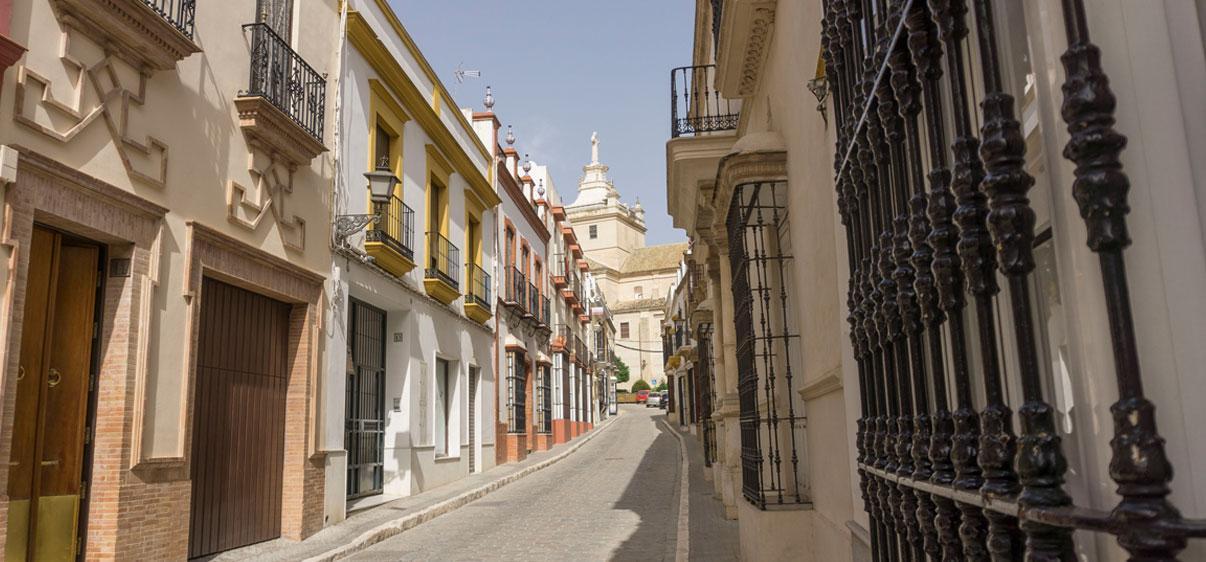
The variety of civil buildings in the town is also wide, with a Cilla del Cabildo (town hall) designed by Alberto de Figueroa and the palatial homes in San Juan Square and in Mesones, Torres and Santa Clara Streets, as well as Sevilla and de las Torres Streets are all architectonic ensembles from the 18th and 19th centuries.
Marchena’s historic-artistic patrimony no doubt surpasses that of many Spanish capital cities. But the value of historic patrimony is not lesser than that of the lyric repertory that, split into thousands of strophes, changed from being a major dramatic piece to being a simple song, sung by the nazarenos during their penitential procession, or by an anonymous voice emerging from the mass of spectators.
Marchena preserves the cuartas ̶ they owe their names to the number of verses ̶ that belong to the Brotherhood of Jesús el Nazareno, the quintasof the Brotherhood of Cristo de San Pedro and the Dulce Nombre, or that of pie quebrado ̶ echoing the Coplas by Jorge Manrique ̶ “owned” by the Brotherhood of Cristo de la Humildad, of Santa Clara. All these chants use the simple melody of the plain chant of that primitive Gregorian, which Spanish surrealist filmmaker from Calanda, Luis Buñuel, catapulted into international fame in “Simon of the Desert”, become an up and down of melismas in those carceleras, in macamas getting out though the windows of the prison, a big rambling shed that still stands.
Both, tangible and intangible patrimony gather in the twists and turns of streets and squares in an exceptional synthesis, and one that it customary at the same time. As we leave Marchena, all those dormitory towns come to our mind, equally big and desolate, which increasingly trap our cities with nothing in exchange.
Here, the white spot of houses in the middle of the Sevillian countryside is like a hope of the sun at a summer midday. It is like an inheritance used every day with no waste.
Antonio Zoido. Writer.
[1] Opus Sectile is a technique used by Romans consisting of the combination of materials and colours that, cut in a small thickness, are arranged to fill the spaces with ornamental purposes.

